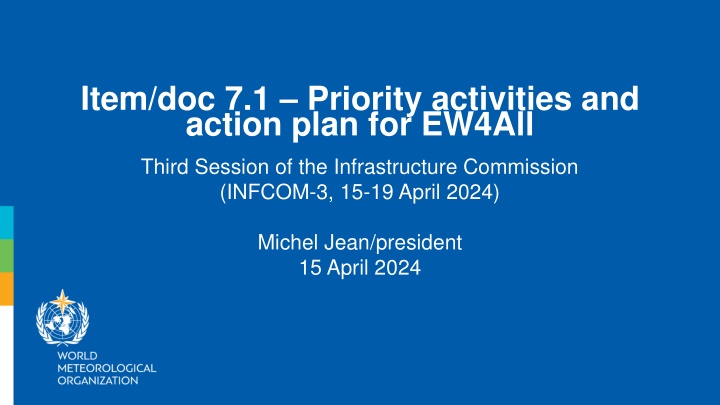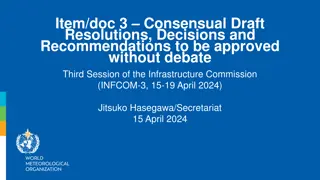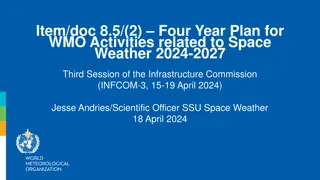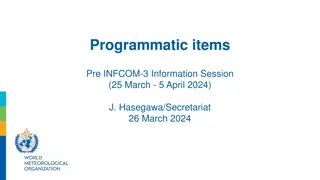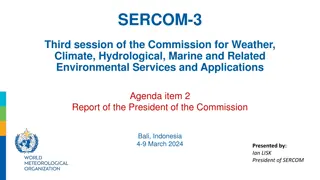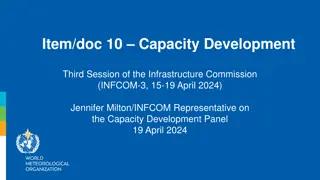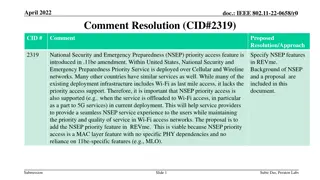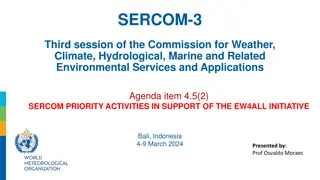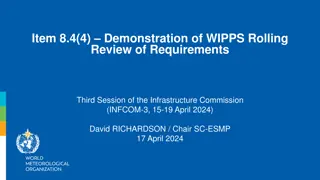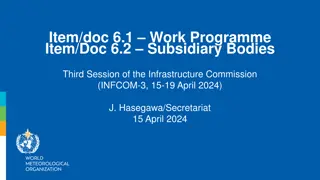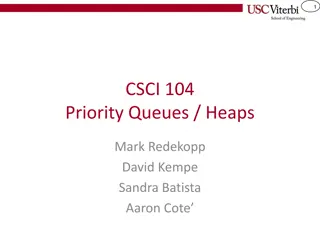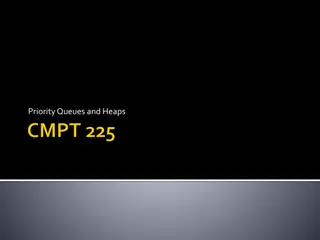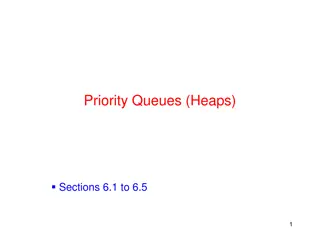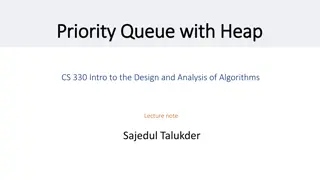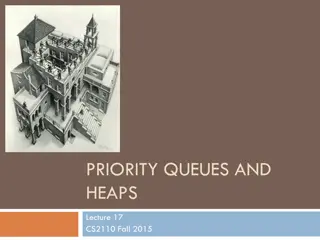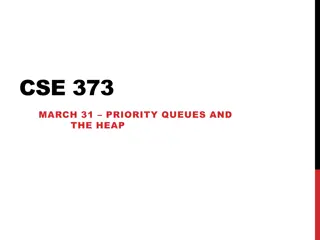Priority Activities and Action Plan for EW4All Infrastructure Commission: INFCOM-3 Session
The document outlines the priority activities and action plan for the Third Session of the Infrastructure Commission (INFCOM-3) within the Early Warnings for All initiative. It includes background decisions, a draft list of priority activities, and an action plan for contributions to the initiative. The resolutions by Congress and the Executive Council highlight the urgency in addressing Member needs related to effective MHEWSs. Rapid assessment, coordination, and pillar assessments form key components of the action plan for enhancing early warning systems. The document also emphasizes the importance of technical coordination through the Technical Coordination Committee (TCC) in aligning efforts under the EW4All umbrella.
Download Presentation

Please find below an Image/Link to download the presentation.
The content on the website is provided AS IS for your information and personal use only. It may not be sold, licensed, or shared on other websites without obtaining consent from the author.If you encounter any issues during the download, it is possible that the publisher has removed the file from their server.
You are allowed to download the files provided on this website for personal or commercial use, subject to the condition that they are used lawfully. All files are the property of their respective owners.
The content on the website is provided AS IS for your information and personal use only. It may not be sold, licensed, or shared on other websites without obtaining consent from the author.
E N D
Presentation Transcript
Item/doc 7.1 Priority activities and action plan for EW4All Third Session of the Infrastructure Commission (INFCOM-3, 15-19 April 2024) Michel Jean/president 15 April 2024
Content 1. Background Decisions of Congress and the Executive Council Rapid Assessment by the Secretariat Coordination through the Technical Coordination Committee Action plan of the Infrastructure Commission 2. draft Decision 7.1/1 List of INFCOM priority activities contributing to the Early Warnings for All initiative 3. draft Recommendation 7.1/1 Action Plan for INFCOM contributions to the Early Warnings for All initiative
Decisions of Congress and the Executive Council Resolution 4 (Cg-19), Congress requested the technical commissions to identify high priority activities to address the urgent needs of Members in building effective MHEWSs falling within their terms of reference (ToR) and to incorporate them into their respective work plans for the next financial period Resolution 1 (EC-77), requested the RAs, technical commissions and RB, under the guidance of EC, to consolidate all their relevant activities under the EW4All umbrella and report back to EC; Resolution 7 (EC-77) - Subsidiary bodies of the Executive Council, delegated the role of coordinating the technical bodies of the Organization (technical commissions, the RB, and other relevant bodies) and the RAs to the Technical Coordination Committee (TCC).
Pillar 2 Rapid Assessment Purpose: To inform the planning stage of EW4All through baseline data and analysis, and to identify the areas with the capacity gaps. 1) Developed by the Secretariat for appraising the monitoring and forecasting capacity of the 30 countries selected by the UN for coordinated assistance, based on interviews (self- reported data), structured along the seven elements of the hydromet value chain: i. Legal framework and institutional mechanisms of the NHMS ii. Observation infrastructure iii. Hazard monitoring capacity iv. Use of remote-sensing data v. Use of NWP models and forecasting tool application vi. Impact-based forecasting capacity vii. Warning services and early warning system operations 2) The Country Hydromet Diagnostics (CHD) were conducted in all 30 countries as part of the SOFF readiness phase, to validate the self-reported data through the peer advisors and the Secretariat Regional Offices and project managers.
Priority hazards coordinated through TCC Chart Title Number of countries that identified the hazard as one of 5 priorities 25 Eventually, priority hazards covered by the EW service need to be decided by each country. For the short-term actions, TCC identified Flood, Drought, TC, heatwave plus Thunderstorm/squall lines ad priority hazards. This is largely based on the results of the Rapid Assessment conducted by the WMO Secretariat. 20 15 10 5 0
Consolidated list of priority activities coordinated through TCC Consolidated list of priority activities by INFCOM, SERCOM and RB produced; INFCOM priority activities are included. A narrative version is presented as INFCOM-3/INF 7.1. Reviewed by Members through Regional Associations. Roadmap for WMO contribution to EW4All is being developed, submitted to EC-78 as an INF document, which is based on the consolidated list of priority activities (INFCOM-3 decision will be reflected).
Action plan of the Infrastructure Commission to carry out a quick gap analysis in global frameworks for observation and prediction data provision and draft an action plan Draft Decision 7.1/1 Priority activities of INFCOM contributing to EW4All Draft Recommendation 7.1/1 - Action Plan for INFCOM contributions to EW4All Task Team on EW4All to assess available global products from traditional and non- traditional sources for riverine flood prediction, in terms of their quality and operational availability, and the possibility to include riverine flood prediction as a new WIPPS activity as a desktop study. draft Recommendation 8.4(3)/1 Task Team on non- traditional sources
Document 7.1 Draft Decision 7.1/1 to decide priority activities of INFCOM Implement the WMO Information System (WIS) 2.0, including the development of a Common Alerting Protocol (CAP) editor to be part of the WIS 2.0 in a box and the development of the WMO Hydrological Observing System (WHOS) in the pre-operational phase of WIS 2.0; Implement the Global Basic Observing Network (GBON), including through the (support provided by/via the) Systematic Observations Financing Facility (SOFF); Guide and support the development of the Regional Basic Observing Network (RBON); Analyse gaps and enhance WMO Integrated Processing and Prediction System (WIPPS) products for priority hazards, including: Enhance the information and service cascading process of the Severe Weather Forecasting Programme (SWFP), the Climate Services Information System (CSIS), and the Tropical Cyclone Programme (TCP); and Improve accessibility and usability of WIPPS products including graphical products; Enhance engagement of academic and private-sector players in WIPPS development; Enhance the introduction of new emerging technologies (e.g., Artificial Intelligence (AI)) and science into WIPPS; Catalogue and analyse gaps of satellite products and applications for priority hazards; Support Members to ensure access to satellite data and products and with train-the-trainers focused on access, processing, visualization, and interpretation of satellite data; and Address the needs for cryosphere-related emerging hazards.
Document 7.1 Draft Recommendation 7.1/1 to propose the Action Plan Action Plan for infrastructure components contributing to EW4All, consisting of work plans to: 1. consider EW4All observational user requirements and gaps through the Regional Basic Observing Network, 2. address the gaps in satellite data/products, 3. analyse gaps and enhance WMO Integrated Processing and Prediction System products for priority hazards, and 4. address cryosphere-related emerging hazards These areas require coordinated actions by the RAs, technical commissions and the RB; the Action Plan is intended to be used as a supporting material for coordination among these bodies, by the Technical Coordination Committee.
Thank you. wmo.int
